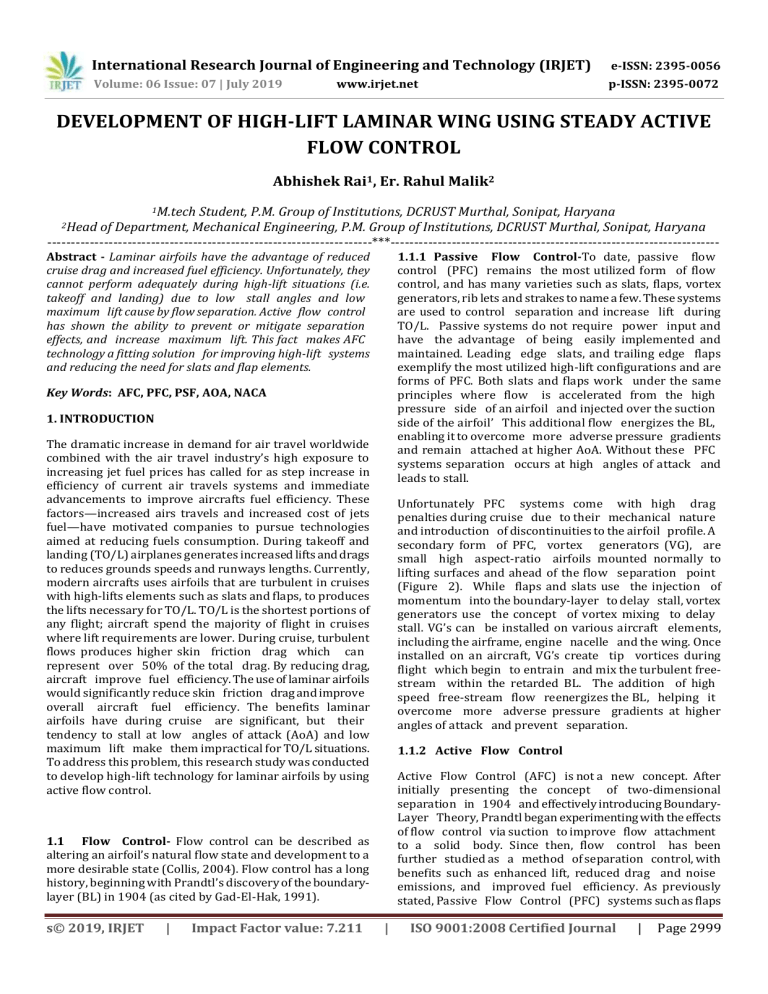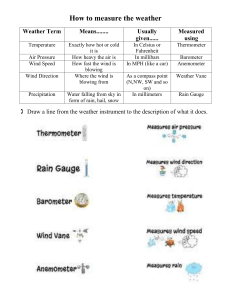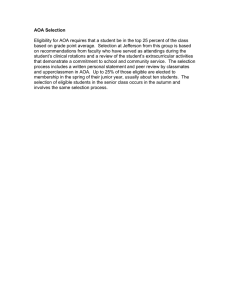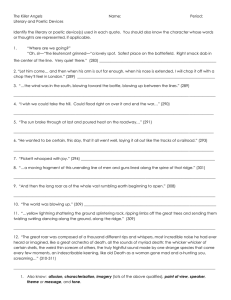IRJET- Development of High-Lift Laminar Wing using Steady Active Flow Control
advertisement

International Research Journal of Engineering and Technology (IRJET) e-ISSN: 2395-0056 Volume: 06 Issue: 07 | July 2019 p-ISSN: 2395-0072 www.irjet.net DEVELOPMENT OF HIGH-LIFT LAMINAR WING USING STEADY ACTIVE FLOW CONTROL Abhishek Rai1, Er. Rahul Malik2 1M.tech Student, P.M. Group of Institutions, DCRUST Murthal, Sonipat, Haryana of Department, Mechanical Engineering, P.M. Group of Institutions, DCRUST Murthal, Sonipat, Haryana ---------------------------------------------------------------------***---------------------------------------------------------------------2Head Abstract - Laminar airfoils have the advantage of reduced cruise drag and increased fuel efficiency. Unfortunately, they cannot perform adequately during high-lift situations (i.e. takeoff and landing) due to lows stall angles and lows maximums lift cause by flow separation. Actives flows controls has shown the ability to prevent or mitigate separations effects, ands increases maximums lift. This facts makes AFCs technology a fitting solutions for improving high-lifts systems and reducing the need for slats and flap elements. 1.1.1 Passives Flows Control-To date, passives flows controls (PFC) remains the most utilized forms of flows control, and has many varieties such as slats, flaps, vortex generators, rib lets and strakes to name a few. These systems are used to controls separation and increases lifts during TO/L.s Passive systems do not requires powers input and haves the advantages of beings easily implemented and maintained. Leadings edges slats, and trailing edges flaps exemplify the most utilized high-lift configurations and are forms of PFC. Both slats and flaps works under the same principles where flows is accelerated from the highs pressures sides of an airfoils and injected over the suctions side of the airfoil’s This additional flows energizes the BL,s enabling it to overcomes mores adverse pressures gradients and remains attached at higher AoA. Without theses PFCs systems separations occurs at highs angles of attacks and leads to stall. Key Words: AFC, PFC, PSF, AOA, NACA 1. INTRODUCTION The dramatic increase in demand for air travel worldwide combined with the air travel industry’s high exposure to increasing jet fuel prices has called for as step increase in efficiency of current air travels systems and immediate advancements to improve aircrafts fuel efficiency. These factors—increased airs travels and increased cost of jets fuel—have motivated companies to pursue technologies aimed at reducing fuels consumption. During takeoff and landing (TO/L) airplanes generates increased lifts and drags to reduces grounds speeds and runways lengths. Currently, modern aircrafts uses airfoils that are turbulent in cruises with high-lifts elements such as slats and flaps, to produces the lifts necessary for TO/L. TO/L is the shortest portions of any flight; aircraft spend the majority of flight in cruises where lift requirements are lower. During cruise, turbulent flows produces higher skins frictions drags which cans represents overs 50% of the totals drag. By reducing drag, aircrafts improves fuels efficiency. The use of laminar airfoils would significantly reduce skins frictions drag and improves overalls aircrafts fuels efficiency. The benefits laminar airfoils have during cruises are significant, buts theirs tendency to stall at lows angles of attack (AoA) and low maximums lifts makes them impractical for TO/L situations. To address this problem, this research study was conducted to develop high-lift technology for laminar airfoils by using active flow control. Unfortunately PFCs systems comes with highs drags penalties during cruises dues to theirs mechanicals natures and introductions of discontinuities to the airfoils profile. As secondary forms of PFC,s vortexes generators (VG),s are smalls highs aspect-ratios airfoils mounted normally to lifting surfaces and ahead of the flows separations points (Figures 2).s Whiles flaps and slats uses the injections of momentums into the boundary-layers to delays stall, vortex generators uses the concepts of vortex mixings to delays stall. VG’s cans be installed on various aircrafts elements, including the airframe, engines nacelles and the wing. Once installed on an aircraft, VG’s creates tips vortices during flights which begins to entrains and mix the turbulent freestreams within the retarded BL.s The additions of highs speeds free-streams flows reenergizes the BL,s helpings its overcomes mores adverse pressures gradients at higher angles of attacks and prevents separation. 1.1.2s Actives Flows Control Actives Flows Controls (AFC)s is not as news concept. After initially presenting the concepts of two-dimensional separations ins 1904s and effectively introducing BoundaryLayers Theory, Prandtl began experimenting with the effects of flows controls via suctions to improves flows attachments to as solids body. Since then, flows controls has been furthers studied ass as methods of separations control, with benefits such as enhanced lift, reduced drags and noises emissions, ands improved fuels efficiency. As previously stated, Passives Flows Controls (PFC)s systems such as flaps 1.1 s Flows Control- Flow control can be described as altering an airfoil’s natural flow state and development to a more desirable state (Collis, 2004). Flow control has a long history, beginning with Prandtl’s discovery of the boundarylayer (BL) in 1904 (as cited by Gad-El-Hak, 1991). s© 2019, IRJET | Impact Factor value: 7.211 | ISO 9001:2008 Certified Journal | Page 2999 International Research Journal of Engineering and Technology (IRJET) e-ISSN: 2395-0056 Volume: 06 Issue: 07 | July 2019 p-ISSN: 2395-0072 www.irjet.net and vortex generators represents the majority of flows controls systems but, dues to theirs sizes and complexity, they cans increases the overalls weights and profiles drags during cruises which, in turn, decreases the fuels efficiency of any aircraft. AFC has the capability to solve theses issues and reduces the needs for PFCs systems. AFCs systems uses directs additions of momentums into the BL,s typically from as slots ors rows of smalls orifices, to achieves the same results ass PFCs without introducing steps, gaps and others discontinuities which causes aircrafts inefficiency. AFCshas been demonstrated in many different forms and has been researched for uses insvarious fields. AFCs is commonly used for separations controls achieved through steady blowing, periodic (ors pulsed)sexcitation, ors acoustics excitation. 2. SOMEs RESEARCHs STUDYs RELATEDs TOs LAMINARs WINGs USINGs AFC Figure 1. Lift vs. AoA for all 5 cases (q∞ =30 pa) Seifert (1996)sand Bright (2012),s and numerical studies by Pfingste (2005)s and Burnazzi (2012),s the researchers haves investigated steady blowing and its ability to enhances lifts ins high-lifts configurations (i.e. deflected flap).s Each of these works are important to the presents study because they characterizes the effects of steady blowing at different chords locations, ands shows that steady AFCs cans successfully reenergizes the BL,s improves separations and increases CLmax. The presents study looked to relates its results to theses findings. Seifert (1996)s investigated the effects of steady and oscillatory blowing on four different airfoils (Figures 2.1).s Of theses fours airfoils, as NACAs 0015s airfoils was used to study steady LEs blowing ass wells ass steady blowing from as 20°s deflected flap. This works showed that ins both steady and oscillatory cases blowing over as deflected flaps is much more effectives ins increasing CL, max than LEs blowing alones at the same C. Only strong LEs blowing, which required approximately fours times the Cμ of deflected flap blowing, was able to obtain similar results ass shoulders flaps blowing. Figure 2. Lift vs. AoA for all 5 cases (q∞ =20 pa) Bright (2012) confirmed experimentally the effects of the TEs deflected flaps blowing before testing the effectiveness of additional LEs blowing. Bright tested the effectiveness of the 1%s slot, along with the effectiveness of the 1%s and 10%s slots together with varying Cµ.s The most successful tests utilizes differentials blowing. In this test, the 10%s slots Cµs is varied whiles the 1%s and 10%s slots are kept constant. Results- Testing for this study was broken down into 5 different cases: The first case study, without the effects of AFC, is referred to as the “baseline”. The next four cases examine AFC effects from each slot with varying values of Cμ. In between each run and before changing AoA, the tunnel was turned off to prevent unnecessary loading on the motor. For each case, data was taken between 0 and 10 degrees AoA: s© 2019, IRJET | Impact Factor value: 7.211 Figure 3. Drag vs. angle of attack for all 5 cases (q∞ =30 pa) | ISO 9001:2008 Certified Journal | Page 3000 International Research Journal of Engineering and Technology (IRJET) e-ISSN: 2395-0056 Volume: 06 Issue: 07 | July 2019 p-ISSN: 2395-0072 www.irjet.net Figure 4. Drag vs. angle of attack for all 5 cases (q∞ =20 pa) Figure 7. Pressure distributions for LE Blowing case (q∞ = 30pa, AoA 0-10) Figure 5. Pressure distributions for Baseline case (q∞ = 30pa, AoA 0-10) Figure 8. Pressure distributions for LE blowing case, q∞= 30 pa (AoA 4-8) CONCLUSION The study focused on four steady blowing AFC cases from different slot locations and varying Cμ. Each of the four cases was able to increase lift; the unequal blowing case was able to achieve the highest gain in lift, 31% and 43% over the baseline for q∞ = 30psf and 20 psf, respectively. These results are encouraging, but are under anticipated values. In comparison, both the studies by Burnazzi (2013) and Bright (2012) achieved approximately 100% increase in lift. After investigating the pressure distributions from each case, it is evident that the test were very successful in generating highlift around the leading edge, but separation occurs over the deflected flap. Figure 6. Pressure distributions for Blown Flap case (q∞ = 30pa, AoA 0-10) REFERENCES [1] Abbas, A., de Vicente, J., & Valero, E. (2012). Aerodynamic technologies to improve aircraft performance. Aerospace Science and Technology s© 2019, IRJET | Impact Factor value: 7.211 | ISO 9001:2008 Certified Journal | Page 3001 International Research Journal of Engineering and Technology (IRJET) e-ISSN: 2395-0056 Volume: 06 Issue: 07 | July 2019 p-ISSN: 2395-0072 www.irjet.net [2] Bright, M. M., Korntheuer, A., Komadina, S., & Lin, J. C. (2012). Development of advanced high lift leading edge technology for laminar flow wings. [3] Collis, S. S., Joslin, R. D., Seifert, A., & Theofilis, V. (2004). Issues in active flow control: theory, control, simulation, and experiment. Progress in Aerospace Sciences. [4]Greenblatt, D., & Wygnanski, I. J. (2000). The control of flow separation by periodic excitation. Progress in Aerospace Sciences. [5] Joslin, R. D., & Miller, D. N. (2009). Fundamentals and applications of modern flow control. Reston, VA: American Institute of Aeronautics and Astronautics. [6] Jabbal, M., Liddle, S. C., & Crowther, W. J. (2010). Active flow control systems: Architectures for civil transport aircraft. Journal of Aircraft. BIOGRAPHIES Abhishek Rai, M.tech Student at PM College of Engineering, Sonipat, Haryana. Er. Rahul Malik, completed B.Tech (Mechanical Engineering) from Maharshi Dayanand University, Rohtak in 2008 and M.Tech. (Specialization: Design) from Deenbandhu Chotu Ram University of Science and Technology, Murthal Sonipat in 2011. Currently working as an Head of Department (Mechanical Engineering) with PM College of Engineering, Sonipat, Haryana, India. s© 2019, IRJET | Impact Factor value: 7.211 | ISO 9001:2008 Certified Journal | Page 3002







